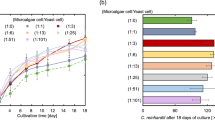Abstract
Kinetics ofChromatium metabolism under autotrophic conditions were studied in batch culture. Description of various over-all metabolic rates in equal dimensions enabled direct comparison of such different processes as electron donor oxidation, storage-polymer synthesis, and growth. In the presence of sulfide, the specific rate of sulfur oxidation is partly depressed. Upon sulfide depletion, the latter rate showed an instantaneous increase of 22%. Simultaneously, glycogen was degraded. These two modifications fully compensate for the absence of sulfide, thus enabling growth to continue withμ max (0.12 h-1). These findings indicate that the potential rate of supply of electrons exceeds the biosynthetic demand for reducing power. The synthesis of glycogen in the presence of sulfide may be regarded overflow metabolism, assuming theμ max is intrinsically limited at 0.12 h-1. An alternative hypothesis is based on the assumption of an ineffective glycogen-synthesis regulation. Conceivably, growth and glycogen synthesis are competing for biosynthetic intermediates, the supply of which is limited by the maximum specific rate of e.g. the Calvin cycle. If so, both growth and glycogen synthesis are performed at submaximal rates. The rate of glycogen synthesis is greatly enhanced by the addition of growth inhibitors, and an increasedμ max value is found in the presence of acetate. These two findings together are consistent with the second hypothesis.
Similar content being viewed by others

Abbreviations
- N c :
-
cell nitrogen
- TS :
-
total sugar
- PHB :
-
poly-β-hydroxybutyrate
- G :
-
glycogen
- D :
-
dilution rate
- CAP :
-
chloramphenicol
- me RP :
-
milliequivalent reducing power
References
Arnon, D. I., Das, V. S. R., Anderson, J. D.: Metabolism of photosynthetic bacteria. I. Effect of carbon source and hydrogen gas on biosynthetic patterns inChromatium. In: Studies on microalgae and photosynthetic bacteria. Spec. Iss. Plant Cell Physiol. (Jap. Soc. Plant Physiol., ed.), pp. 529–545 (1963)
Asami, S., Akazawa, T.: Biosynthetic mechanism of glycolate inChromatium. I. Glycolate pathway. Plant Cell Physiol.16, 631–642 (1975)
Dawes, E. A., Senior, P. J.: The role and regulation of energy reserve polymers in micro-organisms. Adv. Microb. Physiol.10, 135–266 (1973)
Eidels, L., Edelmann, P. L., Preiss, J.: Biosynthesis of bacterial glycogen. VIII. Activation and inhibition of the adenosine diphosphoglucose pyrophosphorylases ofRhodopseudomonas capsulata and ofAgrobacterium tumefaciens. Arch. Biochem. Biophys.140, 60–74 (1970)
Fairbairn, N. J.: A modified anthrone reagent. Chem. Ind.1953, 86 (1953)
Furlong, C. E., Preiss, J.: Biosynthesis of bacterial glycogen. VII. Purification and properties of the adenosine diphosphoglucose pyrophosphorylase ofRhodospirillum rubrum. J. Biol. Chem.244, 2539–2548 (1969)
Gürgün, V., Kirchner, G., Pfennig, N.: Vergärung von Pyruvat durch sieben Arten phototropher Purpurbakterien. Z. Allg. Mikrobiol.16, 573–586 (1976)
Hara, F., Akazawa, T., Kojima, K.: Glycogen biosynthesis inChromatium strain D. I. Characterization of glycogen. Plant Cell Physiol.14, 737–745 (1973)
Harder, W., Van Dijken, J. P.: Theoretical considerations on the relation between energy production and growth of methane utilizing bacteria. In: Proceedings symposium on microbial production and utilization of gasses (H. G. Schlegel, N. Pfennig, G. Gottschalk, eds.), pp. 403–418. Göttingen: Goeltze 1976
Herbert, D., Phipps, P. J., Strange, R. E.: Chemical analysis of the microbial cell. In: Methods in microbiology, Vol. 5B (J. R. Norris, D. W. Ribbons, eds.), pp. 209–344. London: Academic Press 1971
Law, J. H., Slepecki, R. A.: Assay of poly-β-hydroxybutyric acid. J. Bacteriol.82, 33–36 (1961)
Maaløe, O., Kjeldgaard, N. O.: Control of macromolecular synthesis. New York-Amsterdam: Benjamin 1966
Oeding, V., Schlegel, H. G.: β-Ketothiolase fromHydrogenomonas eutropha H16 and its significance in the regulation of poly-β-hydroxybutyrate metabolism. Biochem. J.134, 239–248 (1973)
Palmstierna, H.: Glycogen-like polyglucose inEscherichia coli B during the first hours of growth. Acta Chem. Scand.10, 567–577 (1956)
Pfennig, N., Lippert, K. D.: Über das Vitamin B12-Bedürfnis phototropher Schwefelbakterien. Arch. Mikrobiol.55, 245–256 (1966)
Preiss, J., Kosuge, T.: Regulation of enzyme activity in photosynthetic systems. Ann. Rev. Plant Physiol.21, 433–466 (1970)
Richterich, R.: Klinische Chemie. Frankfurt: Akademische Verlagsgesellschaft 1965
Schmidt, G. L., Kamen, M. D.: Variable cellular composition ofChromatium in growing cultures. Arch. Mikrobiol.73, 1–18 (1970)
Schmidt, G. L., Kamen, M. D.: Control of chlorophyll synthesis inChromatium vinosum. Arch. Mikrobiol.76, 51–64 (1971)
Senior, P. J., Dawes, E. A.: The regulation of poly-β-hydroxybutyrate metabolism inAzotobacter beijerinckii. Biochem. J.134, 255–238 (1973)
Sirevåg, R., Ormerod, J. G.: Carbon dioxide fixation in green sulphur bacteria. Biochem. J.120, 399–408 (1970)
Stouthamer, A. H.: Energetic aspects of the growth of microorganisms. Symp. Soc. Gen. Microbiol.27, 285–315 (1977)
Technicon Instrument Co.: Autoanalyzer manual. New York: Chauncey 1961
Thauer, R. K., Jungermann, K., Decker, K.: Energy conservation in chemotrophic anacrobic bacteria. Bacteriol. Rev.41, 100–180 (1977)
Trüper, H. G., Schlegel, H. G.: Sulphur metabolism in Thiorhodaceae. I. Quantitative measurements on growing cells ofChromatium okenii. Antonie van Leuwenhoek J. Microbiol. Serol.30, 225–238 (1964)
Van Gemerden, H.: Growth measurements ofChromatium cultures. Arch. Mikrobiol.64, 103–110 (1968a)
Van Gemerden, H.: Utifization of reducing power in growing cultures ofChromatium. Arch. Mikrobiol.64, 111–117 (1968b)
Van Gemerden, H.: On the ATP generation byChromatium in darkness. Arch. Mikrobiol.64, 118–124 (1968c)
Van Gemerden, H.: Coexistence of organisms competing for the same substrate: an example among the purple sulfur bacteria. Microb. Ecol.1, 104–119 (1974)
Van Gemerden, H., Jannasch, H. W.: Continuous culture of Thiorhodaceae. Sulfide and sulfur limited growth ofChromatium vinosum. Arch. Mikrobiol.79, 345–353 (1971)
Wilkinson, J. F.: The problem of energy-storage compounds in bacteria. Exptl. Cell Res. Suppl.7, 111–130 (1959)
Author information
Authors and Affiliations
Rights and permissions
About this article
Cite this article
van Gemerden, H., Beeftink, H.H. Specific rates of substrate oxidation and product formation in autotrophically growingChromatium vinosum cultures. Arch. Microbiol. 119, 135–143 (1978). https://doi.org/10.1007/BF00964264
Received:
Issue Date:
DOI: https://doi.org/10.1007/BF00964264



